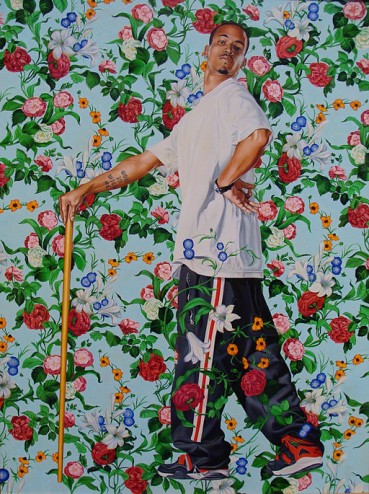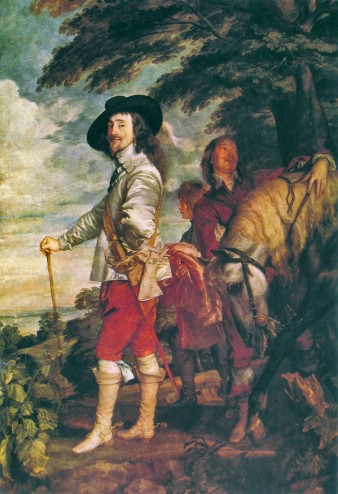 Kehinde Wiley, Le Roi a la chasse, 2006, oil on canvas, 8’ x 6’, Blanton Museum of Art, Austin, Photo by زرشک, Creative Commons Attribution License via Wikimedia Commons.
Kehinde Wiley, Le Roi a la chasse, 2006, oil on canvas, 8’ x 6’, Blanton Museum of Art, Austin, Photo by زرشک, Creative Commons Attribution License via Wikimedia Commons.
During the Baroque era, artists painted religious and political heroes in a style that was intended to impress upon the viewer the supremacy of the subjects and the divine blessings bestowed upon them. This Old Master style is perfectly suited for Kehinde Wiley’s highly skilled and naturalistic portraits that address the image and status of African-American men in today’s culture.
For this particular project, Wiley invited strangers who he met on the street in urban and largely African-American neighborhoods to his studio and asked them to choose an Old Master portrait from (carefully selected) books and then requested that they assume the poses for their portraits. The result is that the subjects adopted the authority of those they imitated in a high and low culture mash-up. His paintings also are commentaries on contemporary notions of masculinity as some embody a type of machismo, while others decidedly are homoerotic. The elaborate and fanciful backgrounds remove the sitter from the context and complicate the interpretation of the gestures.
During the Baroque era, Sir Anthony van Dyck, the promising student of Peter Paul Rubens, landed a plum job as the court painter to the king of England Charles I. After a trip to Italy in the early 1600’s, Van Dyck developed his elegant style of portraiture, elements of which became standard through the eighteenth century. His lines are elongated and graceful, his colors are cool, and the impasto is light. Naturally, this composition (below) glorifies the reign of Charles I. The horse and even the tree bow to his authority. The king’s hand is on his hip as his elbow juts out toward a viewer in a gesture that is very elegant and self-possessed. The cane went with him everywhere – even to his beheading in 1649.
In his redux of Charles I (above), Wiley draws attention to Van Dyck’s regal portrait conventions and questions the constructions of authority that now appear as affectation rather than natural elegance and power. Some may argue that Wiley’s image of a contemporary king is downright campy.

- Sir Anthony van Dyck, King Charles I at the Hunt, c. 1635, oil on canvas, 104.7” x 81.5”, Musée du Louvre, Paris, Public Domain via Wikimedia Commons.
Kehinde Wiley’s paintings are currently on view for another week in the 30 Americans exhibition in the Corcoran Art Gallery in Washington DC.
Other paintings by Kehinde Wiley and their sources
[nggallery id=27]
Watch an interview with the artist and his admirers below
http://www.youtube.com/watch?v=C0pz3v7G96U


